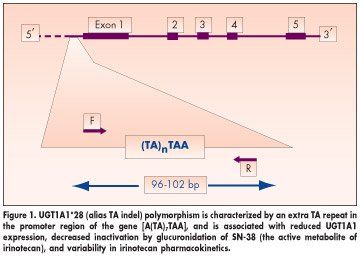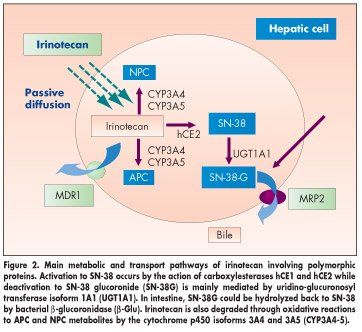Polymorphism Affects Response to, Toxicity of Irinotecan Rx
A polymorphism that reduces the hepatic metabolism of irinotecan (Camptosar) and that is present in about half of patients with colorectal cancer affects their odds of response to and toxicity from regimens containing this agent
SAN FRANCISCOA polymorphism that reduces the hepatic metabolism of irinotecan (Camptosar) and that is present in about half of patients with colorectal cancer affects their odds of response to and toxicity from regimens containing this agent, new data show. The results have implications for dose adjustments in this population, Giuseppe Toffoli, MD, PhD, said at the 2006 Gastrointestinal Cancers Symposium (abstract 222).

Individuals who have the UGT1A1*28 polymorphism have reduced expression of UGT1A1 (UDP-glucuronosyltransferase 1A1), Dr. Toffoli said (Figure 1). This enzyme is responsible for the glucuronidation of the active metabolite of irinotecan (SN-38) in hepatocytes, making it more lipophilic; the glucuronidated form (SN-38-G) is then excreted in bile (see Figure 2). Although the polymorphism leads to decreased glucuronidation of SN-38, the clinical impact of this alteration is not yet clear, he said.

Dr. Toffoli's team performed analyses in 250 patients with metastatic colorectal cancer who received the irinotecan-containing FOLFIRI regimen as first-line therapy. In all patients, the investigators undertook UGT1A1 genotyping. In a subset of 71 patients, they determined the glucuronidation ratio of SN-38 (SN-38-G AUC/SN38 AUC)a marker of enzyme activityand the biliary index for irinotecan (SN-38 AUC/SN-38-G AUC * irinotecan AUC)an indicator of pharmacokinetics. "Because biliary index is dependent on three factors, it could better describe irinotecan metabolism than a single pharmacokinetic parameter," said Dr. Toffoli, of the Centro di Riferimento Oncologico (CRO)National Cancer Institute, Aviano, Italy.
Roughly 45% of the patients had the wild-type genotype (TA6/TA6), while another 45% were heterozygous for the polymorphism (TA6/TA7) and about 10% were homozygous for the polymorphism (TA7/TA7). The glucuronidation ratio differed significantly across these groups, with a markedly lower ratio in patients homozygous for the polymorphism (4.85, 4.32, and 2.41, respectively).
The irinotecan biliary index also differed significantly across groups, Dr. Tofolli said, with a substantially higher index evident in the patients with two copies of the polymorphism (5.13, 5.79, and 9.61 µM*h, respectively).
With regard to hematologic toxicity, differences by genotype were evident only in the first cycle of chemotherapy, Dr. Toffoli said. Compared with their counterparts with the wild-type genotype, patients with one copy of the polymorphism (TA6/TA7) had a nonsignificant increase in the odds of hematologic toxicity of any grade (odds ratio, 3.5), and those with two copies (TA7/TA7) had a significant increase (odds ratio, 8.6). These hematologic toxicities were manageable, he noted. The odds of hematologic toxicity for all cycles did not differ. In addition, the odds of nonhematologic toxicity of any grade did not vary by genotype. "In particular, diarrhea was not associated with this polymorphism," he observed.
In adjusted analyses of responses to the chemotherapy, compared with wild-type patients, those homozygous for the polymorphism had significantly reduced odds of progressive disease (odds ratio, 0.2) and of progressive or stable disease (odds ratio, 0.3). "It means the response rate in these patients was higher than in wildtype patients," Dr. Toffoli said.
Finally, the investigators looked at the possible implications for dose adjustments. Compared with patients who experienced first-cycle hematologic toxicity of grade 0 to 2, those who experienced toxicity of grade 3 or 4 had significantly lower glucuronidation ratios and significantly higher biliary indexes. But overall, patients who had a better response to chemotherapy were also those with a lower ratio and a higher index.
Given the observed associations, Dr. Toffoli said, "the question could be how to increase the biliary index in the patients with low biliary index, our TA6/TA6 patients, patients with the wild type." Based on the equation of biliary index, he noted, one simple strategy is to increase the drug dose. In a companion dose-finding study among 19 patients with gastric cancer treated at three dose levels of irinotecan in addition to docetaxel (Taxotere), increasing dose of irinotecan was associated with a trend toward an increased biliary index, he said.
"The UGT1A1*28 polymorphism is involved in the plasma pharmacokinetics of irinotecan by affecting primarily the glucuronidation ratio, resulting in an increased biliary index," Dr. Toffoli said of the results. A higher biliary index, in turn, favorably affects response, but with the tradeoff of some increased hematologic toxicity. "The observed increased response rate with TA7/TA7 (patients with increased biliary index) suggests a need for careful consideration before a dose reduction in patients carrying the polymorphic TA7 allele is recommended," he concluded.
Newsletter
Stay up to date on recent advances in the multidisciplinary approach to cancer.